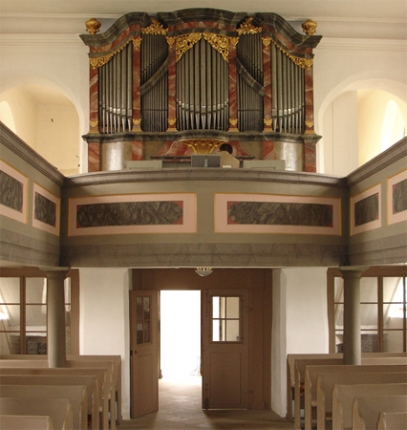

Störmthal bei Leipzig
Zacharias Hildebrandt 1723
State of preservation: Hildebrandt's organ in Störmthal is one of the most precious organs in Saxony, not only because of its links to Bach but its almost untouched preservation. The only losses over history were the stop Posaune 16' and the requisitioned front pipes.
Hildebrandt himself regularly cared for his organ between 1731 and 1754. Smaller repairs were done in 1840 by Urban Kreutzbach, in 1905 by Schmidt und Berger (all of Borna). Hermann Eule replaced the front pipes in 1934.
This orgel was the second of 17 organs in all Hildebrandt built. Contempararies considered it a masterpiece, tested and praised by none other than Johann Sebastian Bach. In the Störmthal parish records of 1723 it was remarked that the organ was "am 2. Novembris, 1723, von dem berühmten Fürstlich Anhaltinischen-Cöthenischen Capellmeister und Directore Music: auch Cantore zu Leipzig Herr Johann Sebastian Bach, übernommen, examinieret, probieret, auch vor tüchtig und beständig erkannt, und gerühmet worden," when "bei öffentlichen Gottesdienste und Einweyhung besagter Orgel" Bach performed his cantata "Höchsterwünschtes Freudenfest" BWV 194.
Music sample
J.S. Bach : Wer nun den lieben Gott läßt walten BWV 691,
played by Christoph Hammer
Specification
I+P
M:
Prinzipal 8’
Gedackt 8’
Quintadena 8’
Prästant 4’
Rohrflöte 4’
Nasat 3’
Oktave 2’
Terz 1 3/5’
Quinte 1½’
Sifflöte 1’
Kornett 3f.
Mixtur 3f.
P:
Subbaß 16’
Prinzipalbaß 8’ (1840)
Posaune 16’
Coupler M/P, Tremulant
© Greifenberger Institut für Musikinstrumentenkunde | info@greifenberger-institut.de




